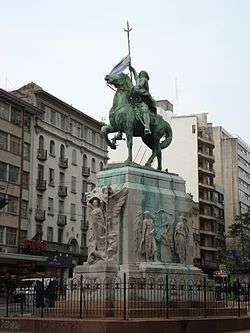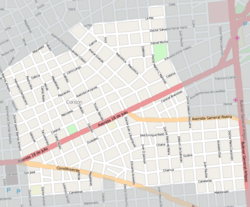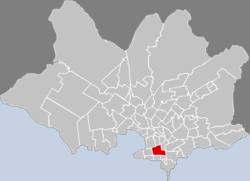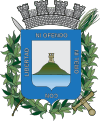Cordón
Cordón is a central barrio (neighbourhood or district) of Montevideo, Uruguay, located directly East of the Centro. Its main avenue is 18 de Julio Avenue. It is delimited by Miguelete Str. and La Paz Str. to the North, Dr. Barrios Amorin Str. to the West, Canelones Str. to the South and Dr. Joaquin Requena Str., and Rivera & Artigas Avenues to the East.
Cordón | |
|---|---|
 The El Gaucho monument, a national symbol, at the West entrance of Cordón, on 18 de Julio Av. | |
 Street map of Cordón | |
 Location of Cordón in Montevideo | |
| Coordinates: 34°54′0″S 56°10′50″W | |
| Country | |
| Department | Montevideo Department |
| City | Montevideo |
Squares
Along 18 de Julio Avenue lies the main square of the Cordón, Plaza de los Treinta y Tres Orientales, also known as Plaza Artola. On it there is a monument to the Thirty-Three Orientals, copy of a painting by national painter Juan Manuel Blanes on painted ceramic tiles, a bronze mounted statue of Juan Antonio Lavalleja, the monument to a fireman holding a baby, as well as a bronze statue of Albert Einstein discussing with the Uruguayan philosopher Carlos Vaz Ferreira, both seated on a bench. On its north side is the Quartel de Bomberos, the firemen's quarters, a building designed by military architect Alfredo R. Campos. Another big square of the area, on Eduardo V. Haedo Str., has been planted with trees recently and is meant to become a park, so it is officially called Parque Liber Seregni.
Buildings and streets
Cordón is home to the National Library, the University of the Republic (the Faculty of Law), the Institute Alfredo Vázquez Acavedo, all three of which are National Heritage Sites, the Ministry of Health, the Banco de Prevision Social (the Social Security Service) and many other building of architectural interest.
Its most important streets apart from 18 de Julio Avenue, are the Constituyente, Uruguay Avenue, Galicia Str., Miguelete Str., Juan D. Jackson which becomes Fernandez Crespo Avenue south of 18 de Julio and others. One street of particular interest is Tristan Narvaja. Apart from being the street of antiquariato books, every Sunday it hosts the historic Feria de Tristán Narvaja a famous street market which is also a tourist attraction.
Educational facilities
- Colegio y Liceo Sagrado Corazón, branded "Seminario" (private, Roman Catholic, Society of Jesus)[1]
Places of worship
There are some important places of worship at this neighbourhood:
- Our Lady of Mt. Carmel, popularly known as "Iglesia del Cordón" (Roman Catholic)
- Church of the Sacred Heart, popularly known as "El Seminario" (Roman Catholic, Jesuits)
- Church of Our Lady of the Rosary and St. Dominic, also known as "Los Domínicos" (Roman Catholic, Dominicans)
Trivia
- The 2014 novel Cordón Soho by Natalia Mardero is set in this neighbourhood.[2]
See also
References
- Seminario
- "Cordón Soho de Natalia Mardero". Montevideo Portal. 3 December 2014.
External links
| Wikimedia Commons has media related to Cordón. |
- Intendencia de Montevideo / Useful data / Cordón
- Intendencia de Montevideo / Historia del Cordón
- Revista Raices / Historia del barrio Cordón
- Page of the Postal Service of Uruguay for the 250 years of Cordón
